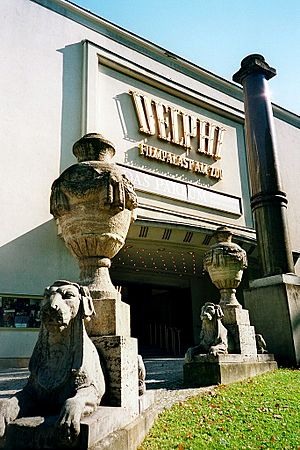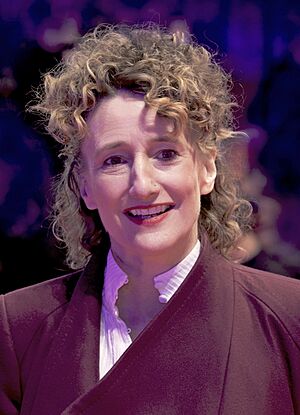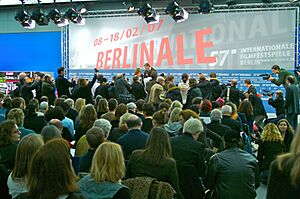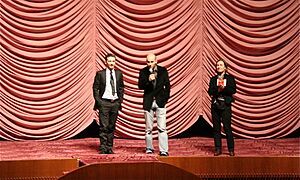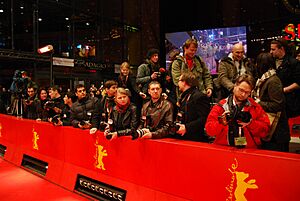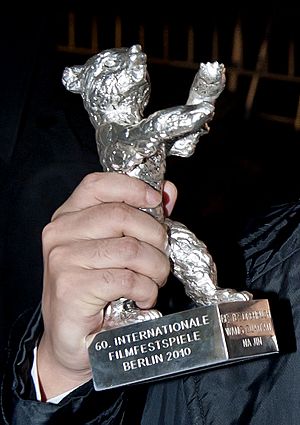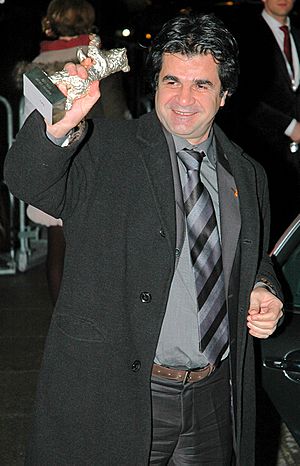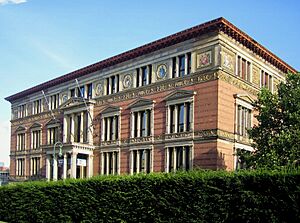Berlin International Film Festival facts for kids
 |
|
| Location | Berlin, Germany |
|---|---|
| Founded | 6 June 1951 |
| Awards | Golden Bear, Silver Bear |
| Artistic director | Tricia Tuttle |
The Berlin International Film Festival, also known as the Berlinale, is a huge movie festival held every year in Berlin, Germany. It started in 1951. Since 1978, it has taken place every February. The Berlinale is one of the "Big Three" film festivals in Europe. The other two are the Venice Film Festival in Italy and the Cannes Film Festival in France. It's also one of the "Big Five" most important film festivals in the world. Many thousands of people visit the festival each year.
Around 400 films are shown at different places across Berlin. Most screenings happen near Potsdamer Platz. Films are grouped into nine different types or sections. About twenty films compete for the top prizes in the "Competition" section. The main awards are the Golden Bear and the Silver Bears. An international group of judges, led by a famous movie person, decides who wins these awards. Other special juries and groups also give out many other awards.
The European Film Market (EFM) happens at the same time as the Berlinale. It's a big meeting for people in the international film business. This market helps movie distributors, buyers, producers, and investors connect. Also, the Berlinale Talents is a week-long event with talks and workshops for young filmmakers. It works together with the festival.
Contents
History of the Berlinale
The idea for a film festival in West Berlin came from Oscar Martay in 1950. He was a film officer from the American administration. The first festival began in June 1951. Dr. Alfred Bauer was the first director of the festival. He held this job until 1976.
Alfred Hitchcock's movie Rebecca opened the first festival. It was shown at the Titania-Palast on June 6, 1951. The festival lasted until June 17. The Waldbühne was another place where films were shown. In 1951, a German group of judges chose the winners. There were five winners of the Golden Bear, given for different types of films.
Early Years and Awards
From 1952 to 1955, the audience chose the winners of the Golden Bear. This was because a group called FIAPF did not allow juries to give prizes at the festival. In 1956, FIAPF officially approved the festival. Since then, an international jury has chosen the Golden Bear winner.
Before the Berlin Wall was built in 1961, some films were also shown in East Berlin. In 1955, the German film Die Ratten won the Golden Bear. In 1957, the Zoo Palast became the main place for the festival. It stayed the main venue until the festival moved to Potsdamer Platz in 2000.
The 1960s and 1970s
In 1963, after the Berlin Wall was built, a daily show of the Berlinale was shown on TV in East Germany. In 1964, there was a disagreement when the film 491 was not allowed in the competition.
The 20th festival in 1970 was stopped early. No awards were given because of a problem with the anti-war film o.k.. The judges decided to remove the film from the competition. They said it went against rules about promoting understanding between nations. This caused a big scandal. Other directors pulled their films from the festival. The judges were accused of censorship and the competition was stopped.
Because of this, it was unclear if the festival would happen the next year. But it was reformed in 1971. A new section called the International Forum for New Cinema was created. In 1975, the first East German film, Jacob the Liar, was shown at the festival.
In 1976, Wolf Donner became the new director. He focused more on German films. He also successfully moved the festival from June to February. This change has stayed the same ever since. The 1978 festival also started the European Film Market. A new section for children's films, "Cinema for People Six and up," also began.
From 1980 to 2000
Moritz de Hadeln took over as director in 1980. He held the position until 2001. In 1986, actress Gina Lollobrigida led the jury. She disagreed with the decision to give the Golden Bear to the film Stammheim. She said the decision was "prefabricated."
The 21st Century Berlinale
In 2001, Dieter Kosslick became the director. He made changes to focus more on German and international films. He also started events to help new filmmakers. In 2010, the city of Berlin created the "Boulevard of the Stars." It honors German actors and filmmakers. Marlene Dietrich was the first to be honored.
In 2015, a new "Series" section was added for long TV shows. In 2018, Mariette Rissenbeek became the executive director. She was the first woman to lead the Berlinale. Carlo Chatrian became the artistic director.
Due to the COVID-19 pandemic, the 71st festival in 2021 was held online. The 73rd festival in February 2023 was the first fully in-person Berlinale since 2020. Tricia Tuttle became the new artistic director in April 2024. The 75th Berlinale in 2025 will be her first festival.
About the Festival
The Berlinale is one of the five most important film festivals in the world. It is also the largest based on how many people attend. In 2020, about 325,000 tickets were sold. Nearly 16,000 film professionals from 130 countries attended. It attracts many thousands of visitors every year.
Around 400 films are shown in different sections. About twenty films compete for the top awards. These are the Golden Bear and Silver Bears. The festival gets money from the German government to help it run.
Mariette Rissenbeek has been the festival's executive director since 2019. Tricia Tuttle became the sole director of the Berlinale in April 2024.
How Films Are Chosen
The festival accepts films of all lengths and types. They prefer films that are shown for the first time internationally or in Europe. Films must have been finished in the year before the festival. Filmmakers can submit their movies starting in September of the year before.
Festival Sections
As of 2025, the festival has eight main sections:
- Competition: These are feature-length films that have not been released outside their home country. They compete for prizes like the Golden Bear for best film and Silver Bears for acting and directing.
- Berlinale Special & Berlinale Series: This section shows a variety of films, special events, and TV series.
- Perspectives: This is a competition for first-time feature films by international filmmakers.
- Berlinale Shorts: This section is for short films. Short films have received Golden and Silver Bears since 1955.
- Panorama: This section shows new and independent films. It focuses on movies that are "explicitly queer, explicitly feminist, explicitly political."
- Forum & Forum Expanded: This section explores the art of filmmaking. It shows about 40 films and is organized by the Arsenal Institute for Film and Video Art.
- Generation: This section has two parts: Generation Kplus and Generation 14plus. They show international films for children and teenagers. This section started in 1978.
- Retrospective, Berlinale Classics & Homage: This section looks back at important films and honors filmmakers for their life's work. It started in 1977.
Awards Given at the Festival
The Golden Bear (Goldener Bär) is the top prize at the Berlin International Film Festival. In 1951, it was given to the best film in five different groups.
From 1952 to 1955, the audience voted for the Golden and Silver Bears. After 1956, an official international jury started deciding the winners. In 1956, a second Golden Bear was added for the best short film. Silver Bears were also added for great acting or directing.
The trophies are statues of a bear. They are based on a sculpture made by Renée Sintenis in 1932. The bear is a symbol of Berlin. Since 1953, copies of the bear have been made by the Noack Foundry.
Main Jury Prizes
The main prizes are given by the international jury. As of 2022, the Golden Bear for Best Film goes to the producers of the best full-length movie.
As of 2022, the Silver Bear awards include:
- Silver Bear Grand Jury Prize
- Silver Bear Jury Prize
- Silver Bear for Best Director
- Silver Bear for Best Leading Performance (for main actors)
- Silver Bear for Best Supporting Performance (for supporting actors)
- Silver Bear for Best Screenplay (for the best story)
- Silver Bear for Outstanding Artistic Contribution (for special artistic work)
Other Berlinale Awards
The Honorary Golden Bear is given for a lifetime of great work in filmmaking. It has been awarded since 1982. It goes to a special guest honored in the "Homage" section.
Awards for short films are given by a separate jury. As of 2022, these include:
- Golden Bear for Best Short Film
- Silver Bear for Best Short Film
Other awards are given by different juries or groups:
- The Berlinale Camera has been awarded since 1986. It thanks people and groups who have helped film in a special way.
- Crystal Bears are given in the "Generation" section for children's and youth films.
- The GWFF Best First Feature Award is for the best first film.
- The Heiner Carow Prize is for the best young German film.
- The Berlinale Documentary Award is for the best documentary film.
- The Berlinale Series Award, started in 2023, is for the winning TV series.
- The Panorama Audience Award is chosen by the audience.
Independent Awards
The Shooting Stars Award is for talented young European actors. It is given by European Film Promotion.
Many other prizes are given by independent groups at the festival. These include:
- FIPRESCI awards for best film in different sections.
- Teddy Awards for films about LGBT topics.
- Prize of the Ecumenical Jury
- Amnesty International Film Award
- Peace Film Prize
Festival Locations
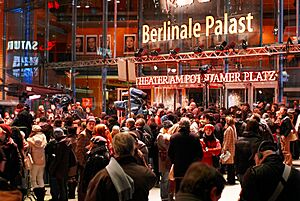
The Theater am Potsdamer Platz is called the Berlinale Palast during the festival. It is where the main competition films premiere. It also hosts the opening and awards ceremonies. The CinemaxX Potsdamer Platz has 19 screens and has been used for press screenings since 2000. The Uber Eats Music Hall, a large hall, also became a screening venue in 2022.
Here are some of the places where films are shown at the Berlinale:
- Berlinale Palast: The main venue with 1639 seats.
- CinemaxX: Used for market and press screenings, with 19 screens.
- CineStar CUBIX: A multiplex cinema with 9 screens.
- Delphi Filmpalast: A historic cinema used for the festival since the 1950s.
- Zoo Palast: Was the main venue from 1957 to 1999, and returned as a venue in 2014.
Related Events
European Film Market (EFM)
The European Film Market (EFM) is a big event for selling and buying films. It started in 1978. It is one of the three largest movie markets in the world. It is the first film market of the year. The EFM is for film professionals like producers, sales agents, and distributors. In 2020, 971 screenings of 732 movies took place. The event happens over eight days at several locations, including the Gropius Bau and the Marriott Hotel.
Berlinale Talents
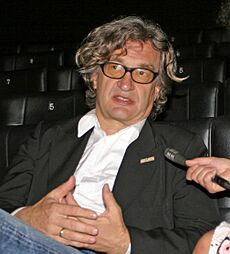
Since 2003, the Berlinale has worked with Berlinale Talents. This is a special program for "up-and-coming filmmakers." It happens at the same time as the festival. About 250 young filmmakers from all over the world are chosen each year.
The event lasts six days. It includes talks and discussions with famous film professionals. Workshops, trips, and personal coaching are also part of the program. Experts like Wim Wenders and Tilda Swinton have given presentations. Many of these talks are available online.
Berlinale Co-Production Market
The Berlinale Co-Production Market is a five-day event. It helps producers, investors, and broadcasters connect for international film projects. It was started in the 2000s.
World Cinema Fund
The World Cinema Fund (WCF) is connected to the Berlinale. It helps provide money for film projects in countries that have a weaker film industry. It was started in 2004. The WCF supports films that have a unique artistic style and tell powerful stories. It helps films that might not get made without extra funding. It gives money for making and distributing full-length films and documentaries. It focuses on countries in Latin America, Africa, the Middle East, and parts of Asia.
Films that have received money from the WCF include:
- Paradise Now (2005, Palestine)
- The Other (2007, Argentina)
- Ajami (2009, Israel/Palestine)
- Talking About Trees (2019, Sudan, Chad)
Images for kids
-
Sharon Stone in 2007
-
Bai Ling in 2007
-
Clint Eastwood at Berlinale in 2007
-
Christopher Lee at Berlinale in 2013
See also
 In Spanish: Festival Internacional de Cine de Berlín para niños
In Spanish: Festival Internacional de Cine de Berlín para niños
- German Cinema
- Cinema of Europe
- List of films set in Berlin
- World cinema


